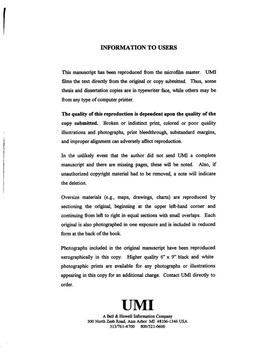| dc.contributor.advisor | Scherman, Avraham, | en_US |
| dc.contributor.author | Burchfield, Deborah Lynn. | en_US |
| dc.date.accessioned | 2013-08-16T12:29:54Z | |
| dc.date.available | 2013-08-16T12:29:54Z | |
| dc.date.issued | 1997 | en_US |
| dc.identifier.uri | https://hdl.handle.net/11244/5570 | |
| dc.description.abstract | Comparisons were made between high-frequency and low-frequency physical activity participants according to gender. Analysis of covariance indicated significant differences between the groups for sports-related Competence, Effort/Importance, and Pressure/Tension, although the differences were not in the predicted direction. There were some gender differences and non-significant trends in the predicted direction for academics-related Interest/Enjoyment. Correlations provided further support for a relationship between involvement in physical activity and motivation for academics, such as sports-related Competence and Effort/Importance. | en_US |
| dc.description.abstract | The sample of students in this study represent a fairly homogeneous population. Additional studies should include a wider variety of students to improve generalizability of results, along with improved research design and more sophisticated statistical analyses. | en_US |
| dc.description.abstract | Research indicates that individuals tend to persist in activities in which they are able to demonstrate competence. Clinical/practical significance of the findings lie in the suggestion that students, for whom sports and academics provide opportunities for the demonstration of competence, and who are involved in physical activity which provides in addition some enjoyment and stress relief, may be able to sustain a higher level of motivation for academics, and thus persist in these areas. Further research is needed to clarify these relationships, and the potential role of physical activity for students experiencing academic motivation difficulties and/or significant amounts of academic-related stress. | en_US |
| dc.description.abstract | One hundred undergraduate students from a small private college in the Midwest completed a package of assessments measuring several components of intrinsic motivation in physical fitness activity/athletics and academics, an instrument measuring general affect, and a demographic questionnaire, to study the question of the relationship between motivation and participation in physical activity to motivation for academics. Two variations of the Intrinsic Motivation Inventory, a sports version and an academic version, were utilized to assess the various components of intrinsic motivation. The Positive Affect Negative Affect Scales were administered to assess general affect. The demographic questionnaire included questions about type and frequency of physical activity, and a "Reasons for Participation" section to ascertain the manifest differences in motivation for participation in physical activity. | en_US |
| dc.format.extent | xi, 70 leaves : | en_US |
| dc.subject | Education, Educational Psychology. | en_US |
| dc.subject | Education, Physical. | en_US |
| dc.subject | Intrinsic motivation. | en_US |
| dc.subject | Education, Higher. | en_US |
| dc.subject | Sports Psychological aspects. | en_US |
| dc.title | Intrinsic motivation and affective differences between high-frequency and low-frequency levels of exercise in college students. | en_US |
| dc.type | Thesis | en_US |
| dc.thesis.degree | Ph.D. | en_US |
| dc.thesis.degreeDiscipline | Department of Educational Psychology | en_US |
| dc.note | Adviser: Avraham Scherman. | en_US |
| dc.note | Source: Dissertation Abstracts International, Volume: 58-10, Section: A, page: 3829. | en_US |
| ou.identifier | (UMI)AAI9812259 | en_US |
| ou.group | Jeannine Rainbolt College of Education::Department of Educational Psychology | |
